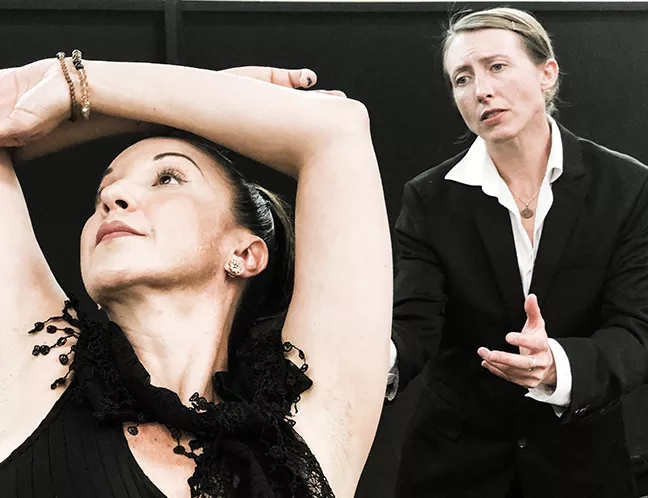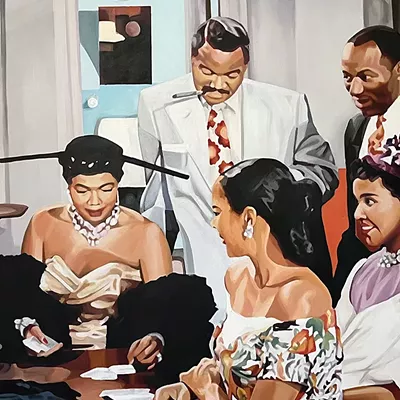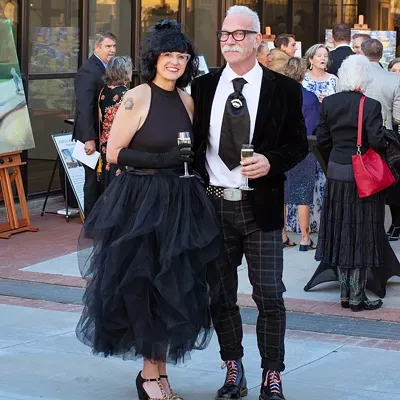A new play told through language and dance and music opens with an homage to still another art form: the visual arts.
In the first scene of Monologue of a Muted Man, set among the winding canals of Venice, Artifact Dance Project dancer Ashley Bowman transforms herself into Leonardo da Vinci's famous Vitruvian Man.
Thrusting both arms out to the side of her body and planting her legs hip-width apart, she mimics the spectacular Leonardo drawing that likens the human body to the universe.
At the same time, actor Robert Anthony Peters reads a passage about the Vitruvian Man from the muted man's monologue.
"These arms outspread equal my height," he says. "It follows I ought to attain my reach... Leonardo never completed the great majority of his projects. I haven't finished any."
This scene reveals the unusual structure of this collaborative play. Dancer Bowman and actor Peters both play the same character, the "muted man" of the title, each using different mediums.
Peters is the man's voice, and he stays on the sidelines, reading the first-person monologue from a mic throughout the one-hour show. Bowman, front and center on stage, plays the young man solely through dance, expressing his thoughts and emotions through body language.
Dancer Claire Hancock, like Bowman a co-director of Artifact Dance Company, silently dances the parts of four other characters.
"Ashley and I get to interact," Hancock says. "It allows us to have fun together."
In an earlier configuration, Hancock was to be the single dancer, performing the role of the man to Bowman's choreography.
"We thought of it as a solo role," Hancock says. But it quickly became apparent that this set-up didn't work. They switched to two dancers, Bowman playing the man, and Hancock dancing the other four characters.
"It makes it much more dynamic," Hancock says.
The play was written by UA prof and prolific playwright Patrick Baliani, a native of Italy.
"He brought us the script," Hancock explains. "It's about a young man losing his hearing in Venice. We had to do it!"
The young man, an admirer of Leonardo, regrets that his own artistic ambitions remain unfulfilled. And as he begins to lose his hearing, he becomes smitten with a beautiful deaf woman, Francesca.
"He's obsessed with her," says Hancock, who dances Francesca. "But he's only observed her from afar."
Throughout the play, the man wanders through Venice, walking along canals, hoping for glimpses of the woman.
"The script goes into great descriptions of Venice, what you might see and hear and smell there," Hancock says. "The writing is beautiful. The man likens the Venice canals to his ear canals, as he loses his hearing."
In keeping with the Artifact tradition of using live music in concerts, the four-part collaborative project—including the two Artifact dancers, playwright Baliani and actor Peters—also features composer Russell Ronnebaum, who wrote a piano score that he plays live throughout.
Baliani's work is often about identity, place and the longing for home, Handcock notes. His award-winning play "Figs and Red Wine" is an immigration story that mirrors his own family's journey from Italy. Other works are adaptations of Italian works, including Dante's Purgatorio and Boccaccio's Decameron.
Muted Man was inspired by the beauty of sign language. After watching an interpreter signing at an event, Baliani became fascinated by its gestural eloquence and by deafness itself.
"In a world of silence, people are more expressive with their gestures," Hancock says. "It makes a nice connection with dance." Dance, she adds, is a "beautiful parallel" to sign language's poetic movements.
Hancock and Bowman co-choreographed the show, with each one composing her own dances while collaborating on the dances they do together. The movement is contemporary, leaning toward narrative to tell the story.
"Ashley directs herself toward the audience, 'speaking' directly through dance." Hancock relies on "pointed and exaggerated" movements to distinguish each of her four characters from the others.
"I've got to physicalize the characters," she says, partly relying on the acting skills she's honed in production at the Rogue Theater, Scamp and Scoundrel, and other companies. "The more I exaggerate, the more the audience will understand who I am at the moment."
As Francesca, the elusive deaf woman, Hancock "opens up her neck and throat, looking up," carefully looking around her with acute vision. As Zanni, Francesca's 9-year-old son, Hancock plays like a "rough and ready" youngster, scampering around and holding imaginary guns.
When she plays the gondolier who guides the muted man through Venice's canals and under its bridges, she tries to suggest a strong man whose "back and arms that are totally ripped" and who takes great pride in his work.
And then there's the brassy woman who works in a gallery where the muted man comes to meditate on the glories of Leonardo. "She's in your face, feisty and direct."
Costumes are also designed to help the audience follow the tale. Peters and Bowman will wear identical men's suits. And Hancock will do quick costume changes to jump from one character to the next. Francesca will be in a dress, her son in shirt and pants, the gondolier in traditional garb and the gallerist in a sexy skirt with a slit up the back.
Donated clothes from Buffalo Exchange will be scattered across the floor, their zig-zag forms intended to suggest the Venetian canals.
The show will be performed in the round at Ina Gittings, a gym that long served as the UA's dance theater. Both dancers performed there as girls and as UA students, before Stevie Eller Dance Theater was built. They're getting a kick out of returning with their own troupe.
"We've rehearsed plenty at Ina Gittings, but Artifact never performed there before," she says.











